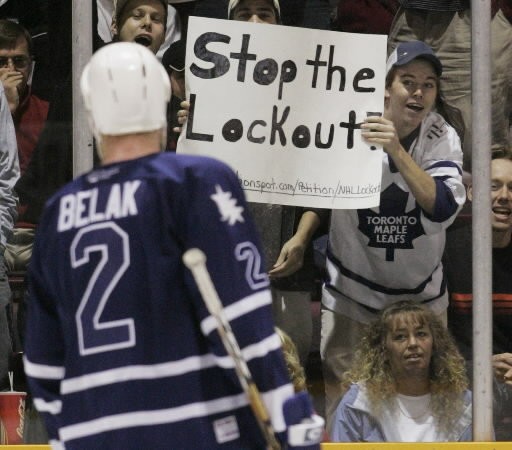This Day in Labor History: September 16, 2004

On September 16, 2004, the National Hockey League chose to lockout its players in order to force them into a salary structure that was a blatant attempt to guarantee profits for the billionaire owners. The salary cap in the NHL, as it was in all leagues, is an artificial attempt to limit costs so that players do not make the money they earn for the franchise. With the National Hockey League Players Association unwilling to back down, the entire 2004-05 season was cancelled, the only time this has ever happened in the history of professional sports.
NHL commissioner Gary Bettman wanted to guarantee cost certainty for owners in the one league where players really did make good money for their work. At least according to an NHL-commissioned report, which we may well want to be quite skeptical of, in 2002-03, players took home 76 percent of league revenues. But even if this is true, I don’t care. Professional sports franchises are not investments so much as they are toys for rich guys. If you don’t want to spend money, sell the team. But it probably wasn’t true. A Forbes magazine report made during the lockout said that the losses teams claimed to justify this were flat out false and probably less than half of what they claimed.
The NHLPA, led by Bob Goodenow, turned the usual right-wing argument on its head. Why not let the free market decided player salaries? No one is making the teams sign players to these big contracts. Maybe if the NHL had presented a luxury tax system like in Major League Baseball, there would have been room to compromise. But the NHLPA was determined to avoid any salary cap and the NHL was determined to implement one, even if it used the cost certainty language instead of calling it by its real name.
It is however to argue the NHL was doing that well though. The league had an almost nonexistent television contract in the United States. The Edmonton Oilers at least made claims that without a labor stoppage, it would just fold up shop.
The NHLPA was not unaware of the league’s problems. And it offered some solutions. It made a proposal that included a luxury tax and reforms to the league entry system, where new signees were getting enormous contracts that were also bothersome to veteran players. The league simply refused to listen to any of this. And in September, the day before the previous contract was set to expire, the NHL announced the lockout.
A lockout is an employers’ strike and it is frustrating how often sports fans will identify with bosses in these scenarios, blaming supposedly greedy players. In this case especially, the NHL was simply happy to not play the game. After the lockout began, there weren’t even serious negotiations until early December, when both sides made offers that the other rejected. The players increased an earlier offer from a 5 percent salary reduction for the upcoming season to 24 percent, but that still wasn’t enough for the NHL. And yet, a poll of Canadians showed that 52 percent of respondents blamed the players for the lockout and only 21 percent blamed the owners.
All talks broke off out of that. In January, knowing that there would be no season if there was not a deal made soon, the NHL and NHLPA attempted to make a deal by excluding Bettman and Goodenow from the talks since the animosity between the two was so intense. But it didn’t matter. On February 14, the union made one last offer to accept a salary cap so long as it was not connected to league revenues. The NHL rejected it. The season was cancelled. The players were not without a Plan B though. The European leagues by no means paid as well as the NHL, but they did offer an opportunity to play and make some money. 388 NHL players went to Europe during the lockout to play. Given the number of European players in the NHL, it was a lot of fun for many of the players to go home for a season.
There were no serious meetings against between the two sides until June. A lot of people wondered whether there would be a season in 2005-06. Would the NHL basically just kill its own league? But the two sides finally sat down seriously and worked well into July. On July 13, the deal was made. It did create a salary cap, one that guaranteed players 54 percent of league revenues. But a salary floor was guaranteed and a system of revenue benchmarks put in place that would increase the percentage of profit that would go to the players if they were met. Moreover, the owners were forced into their own revenue sharing program, which the big teams like the Kings and Rangers did not like since the Oilers and Senators were in pretty small markets.
In the end, the NHL didn’t really suffer for its actions. The league got a better TV deal in the U.S. Most teams have seen their revenues significantly improve in the years since. Unfortunately, the owners once again decided to not let players play in the 2012-13 season, which lasted into January before the season was salvaged. But that lockout is for another post.
This is the 370th post in this series. Previous posts are archived here.


